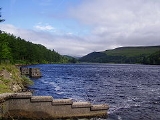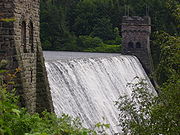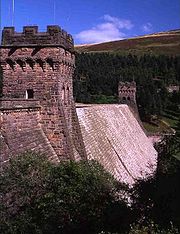
Derwent Reservoir, Derbyshire
Encyclopedia
- Not to be confused with Derwent WaterDerwent WaterDerwentwater is one of the principal bodies of water in the Lake District National Park in north west England. It lies wholly within the Borough of Allerdale, in the county of Cumbria....
in Cumbria , or Derwent Reservoir (North East England)
Derwent Reservoir is the middle of three reservoirs in the Upper Derwent Valley
Upper Derwent Valley
The Upper Derwent Valley is an area of the Peak District National Park in England. It largely lies in Derbyshire, but its north eastern area lies in Sheffield, South Yorkshire...
in the north east of Derbyshire
Derbyshire
Derbyshire is a county in the East Midlands of England. A substantial portion of the Peak District National Park lies within Derbyshire. The northern part of Derbyshire overlaps with the Pennines, a famous chain of hills and mountains. The county contains within its boundary of approx...
, England. It lies approximately 10 mi (16 km) from Glossop
Glossop
Glossop is a market town within the Borough of High Peak in Derbyshire, England. It lies on the Glossop Brook, a tributary of the River Etherow, about east of the city of Manchester, west of the city of Sheffield. Glossop is situated near Derbyshire's county borders with Cheshire, Greater...
and 10 mi (16 km) from Sheffield
Sheffield
Sheffield is a city and metropolitan borough of South Yorkshire, England. Its name derives from the River Sheaf, which runs through the city. Historically a part of the West Riding of Yorkshire, and with some of its southern suburbs annexed from Derbyshire, the city has grown from its largely...
. The River Derwent
River Derwent, Derbyshire
The Derwent is a river in the county of Derbyshire, England. It is 66 miles long and is a tributary of the River Trent which it joins south of Derby. For half its course, the river flows through the Peak District....
flows first through Howden Reservoir
Howden Reservoir
The Howden Reservoir is a Y-shaped reservoir, top one of the three in the Upper Derwent Valley, England. The western half of the reservoir lies in Derbyshire, whereas the eastern half is in Sheffield, South Yorkshire. The county border runs through the middle of the reservoir, following the...
, then Derwent Reservoir and finally through Ladybower Reservoir
Ladybower Reservoir
Ladybower Reservoir is a large Y-shaped reservoir, the lowest of three in the Upper Derwent Valley in Derbyshire, England. The River Ashop flows into the reservoir from the west; the River Derwent flows south, initially through Howden Reservoir, then Derwent Reservoir, and finally through Ladybower...
. Between them they provide practically all of Derbyshire's water, as well as to a large part of South Yorkshire and as far afield as Nottingham
Nottingham
Nottingham is a city and unitary authority in the East Midlands of England. It is located in the ceremonial county of Nottinghamshire and represents one of eight members of the English Core Cities Group...
and Leicester
Leicester
Leicester is a city and unitary authority in the East Midlands of England, and the county town of Leicestershire. The city lies on the River Soar and at the edge of the National Forest...
.
Derwent Reservoir is around 1.5 mi (2 km) in length, running broadly north-south, with Howden Dam at the northern end and Derwent Dam at the south. A small island lies near the Howden Dam. The Abbey Brook flows into the reservoir from the east.
At its peak the reservoir covers an area of 70.8 hectare
Hectare
The hectare is a metric unit of area defined as 10,000 square metres , and primarily used in the measurement of land. In 1795, when the metric system was introduced, the are was defined as being 100 square metres and the hectare was thus 100 ares or 1/100 km2...
s (175 acres) and at its deepest point is 34.7 metres deep.
History

Industrial Revolution
The Industrial Revolution was a period from the 18th to the 19th century where major changes in agriculture, manufacturing, mining, transportation, and technology had a profound effect on the social, economic and cultural conditions of the times...
and urbanisation of the 19th century created huge demand for water in the industrial cities of the East Midlands
East Midlands
The East Midlands is one of the regions of England, consisting of most of the eastern half of the traditional region of the Midlands. It encompasses the combined area of Nottinghamshire, Derbyshire, Leicestershire, Rutland, Northamptonshire and most of Lincolnshire...
and South Yorkshire
South Yorkshire
South Yorkshire is a metropolitan county in the Yorkshire and the Humber region of England. It has a population of 1.29 million. It consists of four metropolitan boroughs: Barnsley, Doncaster, Rotherham, and City of Sheffield...
. The proximity of Sheffield
Sheffield
Sheffield is a city and metropolitan borough of South Yorkshire, England. Its name derives from the River Sheaf, which runs through the city. Historically a part of the West Riding of Yorkshire, and with some of its southern suburbs annexed from Derbyshire, the city has grown from its largely...
and its neighbours to the Upper Derwent valley were thus factors in the decision to dam the valley to create the Howden and Derwent dams.
The neo-Gothic
Gothic Revival architecture
The Gothic Revival is an architectural movement that began in the 1740s in England...
solid masonry dam was begun in 1902, a year after Howden was started, and proved a mammoth task. The huge stones that formed the walls of the dam were carried along a specially created railway from the quarries at Grindleford
Grindleford
Grindleford is a village and parish in the county of Derbyshire, in the East Midlands of England. It lies at an altitude of in the valley of the River Derwent in the Peak District National Park. On the west side of the valley is the high Sir William Hill, and to the south-east lies the gritstone...
. Over 1,000 workers lived in a specially constructed self-contained town called Birchinlee
Birchinlee
Birchinlee is the site of "Tin Town", a village built by the Derwent Valley Water Board for the workers who constructed the Derwent and Howden Dams between 1902 and 1916. Most of the workers had previously been engaged in the construction, in Wales, of the Elan Valley Reservoirs where the...
or "Tin Town". One of the metal huts was preserved and moved to the village of Hope
Hope, Derbyshire
Hope is a village in the Derbyshire Peak District, in England. It lies in the Hope Valley, at the point where Peakshole Water flows into the River Noe. To the north, Win Hill and Lose Hill stand either side of the Noe....
, where it is now a hairdressing salon. The workers that died during the construction of the dam were buried in Bamford Church
Bamford Church
St John the Baptist church is a C of E church in Bamford in the Hope Valley, Derbyshire, England. The building that is seen today is largely a William Butterfield restoration dating from 1861, with a bell tower.- The Bells and Tower :...
.
The reservoir was first begun to be filled in November 1914, and overflowed for the first time in January 1916, with the water almost immediately passing into supply. The dam can support a total of 9.64 million cubic metres of water.
Only two years after the dam's completion in 1916, it was decided that the flow from the reservoir was insufficient to support the surrounding population. As a result, between 1920 and 1931 the rivers Alport
River Alport
The River Alport flows for 9 km in the Dark Peak of the Peak District in Derbyshire, England. Its source is on Bleaklow, from which it flows south through the Grains in the Water swamp, then over gritstone to Alport Bridge on the A57 Snake Pass route from Sheffield to Manchester, where it joins...
and Ashop were also diverted from the Ashop valley into the reservoir using tunnels and a Venturi Flume
Venturi flume
A venturi flume is a critical-flow open flume with a constricted flow which causes a drop in the hydraulic grade line, creating a critical depth.It is used in flow measurement of very large flow rates, usually given in millions of cubic units...
.
The diversion helped hold back water during the construction of the Ladybower Reservoir
Ladybower Reservoir
Ladybower Reservoir is a large Y-shaped reservoir, the lowest of three in the Upper Derwent Valley in Derbyshire, England. The River Ashop flows into the reservoir from the west; the River Derwent flows south, initially through Howden Reservoir, then Derwent Reservoir, and finally through Ladybower...
to the south, which was constructed between 1935 and 1945.
Bamford and Howden Railway

Standard gauge
The standard gauge is a widely-used track gauge . Approximately 60% of the world's existing railway lines are built to this gauge...
railway of over 7 miles (11.3 km) was built from the town of Bamford
Bamford
Bamford is a village in the Derbyshire Peak District, England, close to the River Derwent. To the north-east is Bamford Edge, and to the south-east the location of the water treatment works covering the Ladybower, Derwent and Howden Reservoirs. Though locally Bamford is described as being in the...
to the south of the reservoir to Howden, to carry the thousands of tons of stone required for the construction of the two dams. Near to the southern end lay the newly opened quarry at Bole Hill near Grindleford.
Remains of the railway can still be seen alongside Derwent Reservoir as well as at the western end of the Ladybower dam where over 1.5 miles (2.4 km) of cutting and trackway remain, and are known locally as 'The Route'. Between the Howden and Derwent dams the present road was built over the top of the railway.
After supplying well over a million tons of stone the Bole Hill quarry was closed in September 1914, with the end of the railway following soon after. The section between the mainline railway at Hope
Hope, Derbyshire
Hope is a village in the Derbyshire Peak District, in England. It lies in the Hope Valley, at the point where Peakshole Water flows into the River Noe. To the north, Win Hill and Lose Hill stand either side of the Noe....
and Yorkshire Bridge
Yorkshire Bridge
Yorkshire Bridge is a landmark former packhorse bridge in the English county of Derbyshire.Yorkshire Bridge crosses the River Derwent to the south of the dam of the Ladybower Reservoir from which the river has emerged and is north of the village of Thornhill. It gives its name to a public house on...
was relaid in 1935 to aid the construction of the Ladybower dam, but closed again in 1946.
Countryside

Larch
Larches are conifers in the genus Larix, in the family Pinaceae. Growing from 15 to 50m tall, they are native to much of the cooler temperate northern hemisphere, on lowlands in the north and high on mountains further south...
, pine
Pine
Pines are trees in the genus Pinus ,in the family Pinaceae. They make up the monotypic subfamily Pinoideae. There are about 115 species of pine, although different authorities accept between 105 and 125 species.-Etymology:...
, and spruce
Spruce
A spruce is a tree of the genus Picea , a genus of about 35 species of coniferous evergreen trees in the Family Pinaceae, found in the northern temperate and boreal regions of the earth. Spruces are large trees, from tall when mature, and can be distinguished by their whorled branches and conical...
conifers, with the remaining third mainly sycamore
Sycamore Maple
Acer pseudoplatanus, the sycamore maple, is a species of maple native to central Europe and southwestern Asia, from France east to Ukraine, and south in mountains to northern Spain, northern Turkey, and the Caucasus. It is not related to other trees called sycamore or plane tree in the Platanus...
, beech
Beech
Beech is a genus of ten species of deciduous trees in the family Fagaceae, native to temperate Europe, Asia and North America.-Habit:...
and oak
Oak
An oak is a tree or shrub in the genus Quercus , of which about 600 species exist. "Oak" may also appear in the names of species in related genera, notably Lithocarpus...
.
The hills of the Peak District
Peak District
The Peak District is an upland area in central and northern England, lying mainly in northern Derbyshire, but also covering parts of Cheshire, Greater Manchester, Staffordshire, and South and West Yorkshire....
are given over to the pasture of sheep, leased to local farmers. The moorlands and gritstone edges are criss-crossed by footpaths open year-round other than during selected shooting periods.
Dambusters
During the Second World War the reservoir was used by pilots of the 617 Squadron for practising the low-level flights needed for Operation ChastiseOperation Chastise
Operation Chastise was an attack on German dams carried out on 16–17 May 1943 by Royal Air Force No. 617 Squadron, subsequently known as the "Dambusters", using a specially developed "bouncing bomb" invented and developed by Barnes Wallis...
(commonly known as the "Dam Busters" raids), due to its similarity to the German dams. Today there is a commemorative plaque to 617 Squadron on the dam, and one of the towers on the dam houses the Derwent Valley Museum. The exhibition, owned and run by Vic Hallam, tells the tale of Squadron 617 and its training for Operation Chastise and also has a display on the history of the Derwent valley and the lost villages of Derwent
Derwent, Derbyshire
Derwent is a village 'drowned' under the Ladybower Reservoir in Derbyshire, England. The village of Ashopton, Derwent Woodlands church and Derwent Hall were also 'drowned' in the construction of the reservoir. There is no formal memorial to any of the villages...
and Ashopton
Ashopton
Ashopton was a village in Derbyshire, England, that was lost along with neighbouring Derwent when the Ladybower Reservoir was constructed in the late 1930s and early 1940s....
. Occasional flypast
Flypast
Flypast is a term used in the United Kingdom, the Commonwealth, and other countries to denote ceremonial or honorific flights by groups of aircraft and, rarely, by a single aircraft...
s of the Battle of Britain Memorial Flight
Battle of Britain Memorial Flight
The Battle of Britain Memorial Flight is a Royal Air Force flight which provides an aerial display group comprising an Avro Lancaster, a Supermarine Spitfire and a Hawker Hurricane...
at the reservoir are also staged to commemorate the events during the war.

